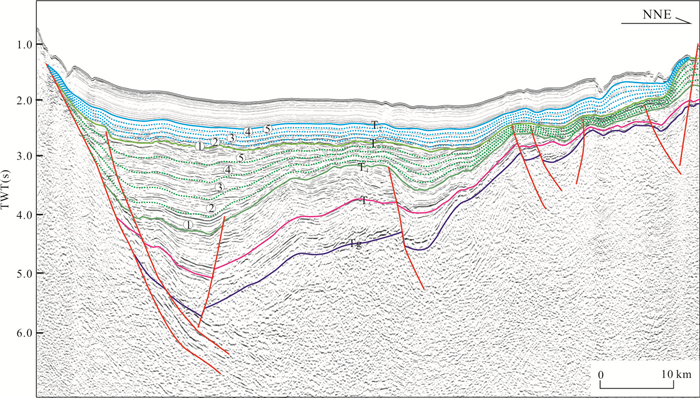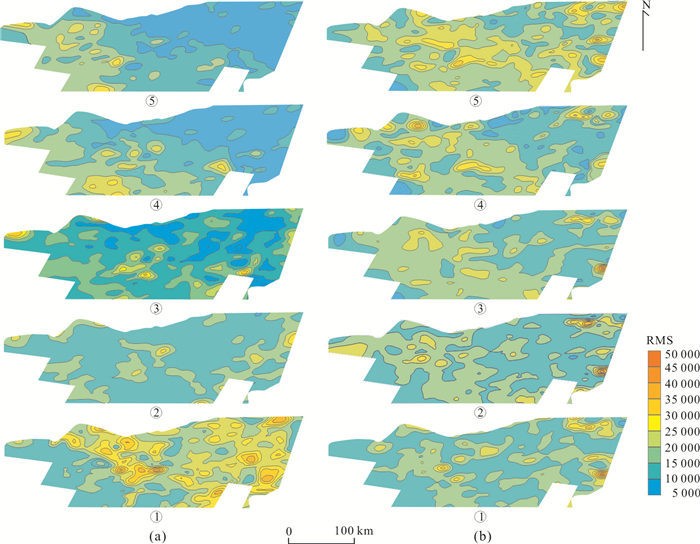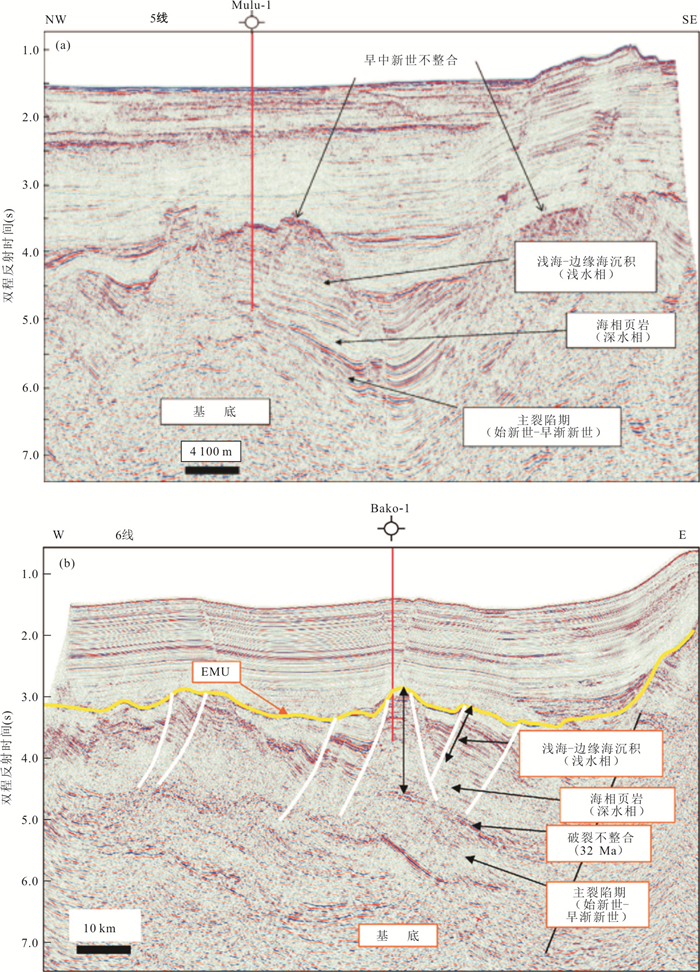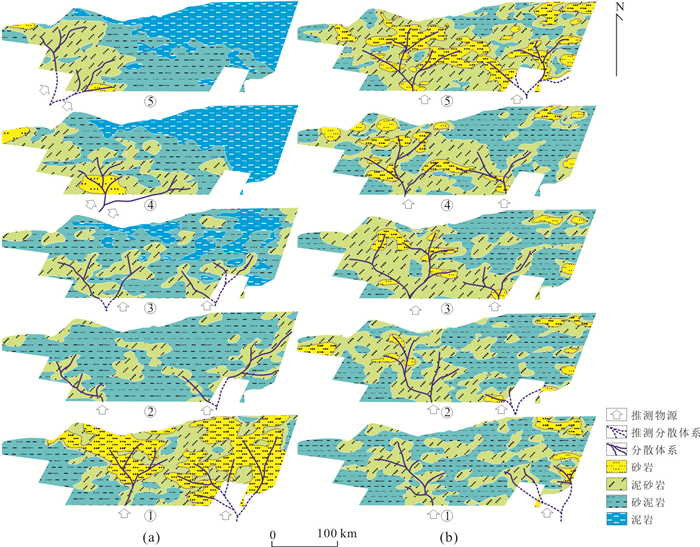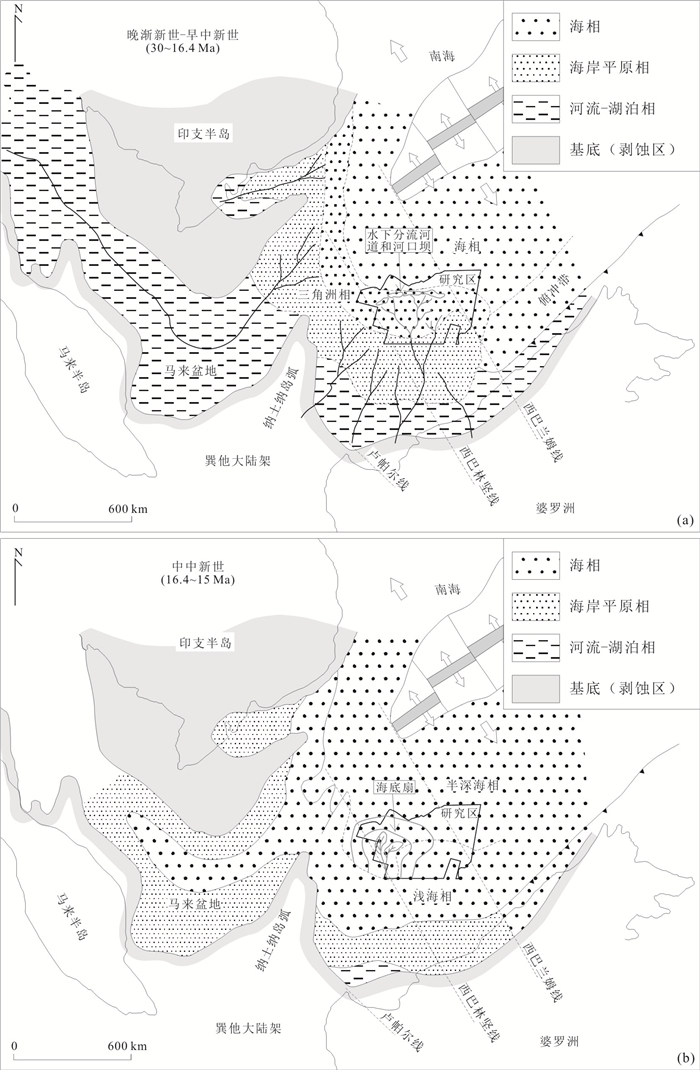Provenance Migration in the Beikang Basin of the Southern South China Sea during the Oligocene to the Mid-Miocene
-
摘要: 晚渐新世-中中新世,南海南部经历了重要的构造变革,北康盆地物源发生了重大变化,引起分散体系的变化,从而影响油气资源分布,因此物源研究具有重要意义.利用地震反射资料,开展地震属性分析,通过RMS(均方根振幅)地层切片,分析分散体系,并探讨物源变化及其控制因素.在晚渐新世-中中新世,北康盆地的沉积物源主要来自南侧,分散体系自南向北;不整合面之后海水突然加深,形成以早中新世不整合面(EMU)为界的2个沉积旋回;在每个旋回内,沉积物补给逐渐增多;在中中新世,沉积物源逐渐向北西方向迁移.通过区域分析,认为北康盆地的物源主要来自南部的曾母前陆盆地,物源的变化是曾母前陆盆地逐渐淤浅成陆和向北推进所致.Abstract: It is significant to research the provenance of Beikang basin in the southern South China Sea, because oil and gas resources were influenced by the changes of dispersion systems resulted from tectonic-induced migration of provenance. In this paper, seismic reflection data were used in seismic attribute analysis, where stratigraphic slices of RMS (root mean square amplitude) were used to analyze dispersion systems, in order to inquire into provenance migration and its controlling factors. During the Later Oligocene to Middle Miocene, the provenance of the Beikang basin was from the south and the dispersion systems extended from south to north. Two depositional cycles were separated by the Early Miocene Uncomformity (EMU), which formed during seawater deepening. In each cycle, sedimentary supply increased gradually upward. During the Middle Miocene, the depositional provenance migrated northwestward gradually. Regional analysis show that the provenance of the Beikang basin mainly came from Zengmu Foreland basin and the provenance migration is caused by landfill and overthrust northward of the Zengmu Foreland basin.
-
图 1 南海南部海域的主要沉积盆地和研究区位置
Fig. 1. The key sedimentary basins and research area in the southern South China Sea
图 4 过井剖面的地震反射特征及沉积解释
Fig. 4. Seismic reflection characteristics and depositional interpretation of cross-well profiles
图 6 北康盆地的沉积物来源及变迁模式
据Madon et al.(2013)改编,研究区内的内容为本文观点
Fig. 6. The sedimentary provenance and migration model in the Beikang basin
-
Braitenberg, C., Wienecke, S., Wang, Y., 2006. Basement Structures from Satellite-Derived Gravity Field:South China Sea Ridge. Journal of Geophysical Research, 111:1-15. https://doi.org/10.1029/2005B003938. 2006 doi: 10.1029/2005B003938.2006 Briais, A., Patriat, P., Tapponnier, P., 1993. Updated Interpretation of Magnetic Anomalies an Seafloor Spreading Stages in the South China Sea:Implications for the Tertiary Tectonics of Southeast Asia. Journal of Geophysical Research, 98 (B4):6299-6328. https://doi.org/10.1029/92jb02280 Clift, P., Lee, G.H., Anh Duc, N., et al., 2008. Seismic Reflection Evidence for a Dangerous Grounds Miniplate:No Extrusion Origin for the South China Sea. Tectonics, 27:1-16. https://doi.org/10.1029/2007TC002216. Cullen, A., 2014. Reprint of:Nature and Significance of the West Baram and Tinjar Lines, NW Borneo. Marine and Petroleum Geology, 58:674-686. https://doi.org/10.1016/j.marpetgeo.2013.11.010 Cullen, A., Macpherson, C., Taib, N.I., et al., 2013. Age and Petrology of the Usun Apau and Linau Balui Volcanics:Windows to Central Borneo's Interior. Journal of Asian Earth Sciences, 76:372-388. https://doi.org/10.1016/j.jseaes.2013.05.003 Cullen, A. B., 2010. Transverse Segmentation of the Baram-Balabac Basin, NW Borneo:Refining the Model of Borneo's Tectonic Evolution. Petroleum Geoscience, 16:3-29. https://doi.org/10.1144/1354-079309-828 Ding, W., Franke, D., Li, J., et al., 2013. Seismic Stratigraphy and Tectonic Structure from a Composite Multi-Channel Seismic Profile across the Entire Dangerous Grounds, South China Sea. Tectonophysics, 582:162-176. https://doi.org/10.1016/j.tecto.2012.09.026 Epting, M., 1989. The Miocene Carbonate Buildups of Central Luconia, Offshore Sarawak. In: Bally, A.W., ed., Atlas of Seismic Stratigrapgy. AAPG Studies in Geology, Tulsa, 168-173. Fuller, M., Ali, J.R., Moss, S.J., et al., 1999. Paleomagnetism of Borneo. Journal of Asian Earth Sciences, 17:3-24. https://doi.org/10.1016/s0743-9547(98)00057-9 Hall, R., 2013. Contraction and Extension in Northern Borneo Driven by Subduction Rollback. Journal of Asian Earth Sciences, 76:399-411. https://doi.org/10.1016/j.jseaes.2013.04.010 Hazebroek, H.P., Tan, D.N.K., 1993. Tertiary Tectonic Evolution of the NW Sabah Continental Margin. Bulletin of the Geological Society of Malaysia, 33:195-210. doi: 10.7186/bgsm33199315 Hutchison, C.S., 1996. The Rajang Accretionary Prism and Lupar Line Problem of Borneo. In: Hall, R., Blundell, D.J., eds., Tectonic Evolution of Southeast Asia. Geological Society of London Special Publication, 106(1): 247-261. https: //doi.org/10.1144/gsl.sp.1996.106.01.16 Hutchison, C.S., 2004. Marginal Basin Evolution:The Southern South China Sea. Marine and Petroleum Geology, 21:1129-1148. https://doi.org/10.1016/j.marpetgeo.2004.07.002 Hutchison, C.S., 2010a. Oroclines and Paleomagnetism in Borneo and South-East Asia. Tectonophysics, 496:53-67. https://doi.org/10.1016/j.tecto.2010.10.008 Hutchison, C.S., 2010b. The North-West Borneo Trough. Marine Geology, 271:32-43. https://doi.org/10.1016/j.margeo.2010.01.007 Hutchison, C.S., Vijayan, V.R., 2010. What are the Spratly Islands?. Journal of Asian Earth Sciences, 39:371-385. https://doi.org/10.1016/j.jseaes.2010.04.013 James, D.M.D., 1984. Regional Geological Setting. In: James, D.M.D., ed., The Geology and Hydrocarbon Resources of Negara Brunei Darussalam. Brunei Museum and Brunei Shell Petroleum Company, Bandar Seri Begawan, 34-42. Krebs, W.N., 2011. Upper Tertiary Chronosequence Stratigraphy of Offshore Sabah and Sarawak, NW Borneo, Malaysia:A Unified Scheme Based on Graphic Correlation. Bulletin of the Geological Society of Malaysia, 57:39-46. doi: 10.7186/bgsm57201106 Levell, B.K., 1987. The Nature and Significance of Regional Unconformities in the Hydrocarbon-Bearing Neogene Sequences Offshore West Sabah. Bulletin of the Geology Society of Malaysia, 21:55-90. doi: 10.7186/bgsm21198704 Lüdmann, T., Wong, H.K., 1999. Neotectonic Regime on the Passive Continental Margin of the Northern South China Sea. Tectonophysics, 311:113-138. https://doi.org/10.1016/s0040-1951(99)00155-9 Madon, M., 1999. North Luconia Province. Petronas, Kuala Lumpur, 441-454. Madon, M., Ly, K.C., Wong, R., 2013. The Structure and Stratigraphy of Deepwater Sarawak, Malaysia:Implications for Tectonic Evolution. Journal of Asian Earth Sciences, 76(2):312-333. https://doi.org/10.1016/j.jseaes.2013.04.040 Ren, J.Y., 2018. Genetic Dynamics of China Offshore Cenozoic Basins. Earth Science, 43(10):3337-3361 (in Chinese with English abstract). https://doi.org/10.3799/dqkx.2018.330 Ru, K., Pigott, J.D., 1986. Episodic Rifting and Subsidence in the South China Sea. AAPG Bulletin, 70:1136-1155. http://cn.bing.com/academic/profile?id=f9c632abe3e2b600b5afde421ccaa1db&encoded=0&v=paper_preview&mkt=zh-cn Schlüter, H.U., Hinz, K., Block, M., 1996. Tectono-Stratigraphic Terranes and Detachment Faulting of the South China Sea and Sulu Sea. Marine Geology, 130(1-2):39-51, 58-78. https://doi.org/10.1016/0025-3227(95)00137-9 Steuer, S., Franke, D., Meresse, F., et al., 2014. Oligocene-Miocene Carbonates and Their Role for Constraining the Rifting and Collision History of the Dangerous Grounds, South China Sea. Marine and Petroleum Geology, 5:644-657. http://www.wanfangdata.com.cn/details/detail.do?_type=perio&id=38e9739b3438000b8ca650b0122f3236 Su, D.Q., Huang, C.L., Xia, K.Y., 1996. The Crust in the Nansha Trough. Scientia Geologica Sinica, 31(4):409-415 (in Chinese with English abstract). Sun, Z., Zhao, Z.X, Zhou, D., et al., 2011. The Stratigraphy and Sequence Architecture of the Basins in Nansha Region. Earth Science, 36(5):798-806 (in Chinese with English abstract). https://doi.org/10.3799/dqkx.2011.082 Tan, D.N.K., Lamy, J.M., 1990. Tectonic Evolution of the NW Sabah Continental Margin since the Late Eocene. Bulletin of the Geology Society of Malaysia, 27:241-260. doi: 10.7186/bgsm27199012 Taylor, B., Hayes, D.E., 1980. The Tectonic Evolution of the South China Sea. In: Hayes, D.E., ed., The Tectonic and Geologic Evolution of Southeast Asian Seas and Islands. Part 1. Geophysical Monograph Series, 23: 89-104. Taylor, B., Hayes, D.E., 1983. Origin and History of the South China Sea Basin. In: Hayes, D.E., ed., The Tectonic and Geologic Evolution of the Southeast Asian Seas and Islands. Part 2. Geophysical Monograph Series, 27: 23-56. https: //doi.org/10.1029/gm027p0023 Vijayan, V.R., Foss, C., Stagg, H., 2013. Crustal Character and Thickness over the Dangerous Grounds and beneath the Northwest Borneo Trough. Journal of Asian Earth Sciences, 76(25):389-398. https://doi.org/10.1016/j.jseaes.2013.06.004 Wang, L., Zhao, Z.G., Xie, X.J., et al., 2019. Reservoir Distribution and Hydrocarbon Accumulation Patterns in Central-Southern South China Sea. Earth Science, 44(3):919-928 (in Chinese with English abstract). https://doi.org/10.3799/dqkx.2018.116 Wang, P.C., Li, S.Z., Guo, L.L., et al., 2016. Mesozoic and Cenozoic Accretionary Orogenic Processes in Borneo and Their Mechanisms. Geological Journal, 51(S1):464-489. https://doi.org/10.1002/gj.2835 Wilson, M.E.J., 2002. Cenozoic Carbonates in Southeast Asia:Implications for Equatorial Carbonate Development. Sedimentary Geology, 147(3-4):295-428. https://doi.org/10.1016/s0037-0738(01)00228-7 Yang, C.P., Yao, Y.J., Li, X.J., et al., 2014. Sequence Stratigraphy and Sedimentary Cycle of Miocene Carbonate Buildups in Zengmu Basin, the Southern South China Sea. Earth Science, 39(1):91-98 (in Chinese with English abstract). https://doi.org/10.3799/dqkx.2014.009 Yang, Z., Zhang, G.X., Zhang, L., 2016. The Evolution and Main Controlling Factors of Reef and Carbonate Platform in Wan'an Basin. Earth Science, 41(8):1349-1360 (in Chinese with English abstract). https://doi.org/10.3799/dqkx.2016.107 Yao, Y.J., Yang, C.P., Li, X.J., et al., 2013. The Seismic Reflection Characteristics and Tectonic Significance of the Tectonic Revolutionary Surface of Mid-Miocene (T3 Seismic Interface) in the Southern South China Sea. Chinese Journal of Geophysics, 56(4):1274-1286 (in Chinese with English abstract). https://doi.org/10.6038/cjg20130422 Zhou, D., Ru, K., Chen, H.Z., 1995. Kinematics of Cenozoic Extension on the South China Sea Continental Margin and Its Implications for the Tectonic Evolution of the Region. Tectonophysics, 251:161-177. https://doi.org/10.1016/0040-1951(95)00018-6 Zhou, H., Xiao, L., Dong, Y., et al., 2009. Geochemical and Geochronological Study of the Sanshui Basin Bimodal Volcanic Rock Suite, China:Implications for Basin Dynamics in Southeastern China. Journal of Asian Earth Sciences, 34:178-189. https://doi.org/10.1016/j.jseaes.2008.05.001 任建业, 2018.中国近海海域新生代成盆动力机制分析.地球科学, 43(10):3337-3361. doi: 10.3799/dqkx.2018.330 苏达权, 黄慈流, 夏戡原, 1996.论南沙海槽的地壳性质.地质科学, 31(4):409-415. http://www.wanfangdata.com.cn/details/detail.do?_type=perio&id=HY000001821124 孙珍, 赵中贤, 周蒂, 等, 2011.南沙海域盆地的地层系统与沉积结构.地球科学, 36(5):798-806. doi: 10.3799/dqkx.2011.082 王龙, 赵志刚, 谢晓军, 等, 2019.南海中南部区域储层分布规律及油气成藏模式.地球科学, 44(3):919-928. doi: 10.3799/dqkx.2018.116 杨楚鹏, 姚永坚, 李学杰, 等, 2014.南海南部曾母盆地中新世碳酸盐岩的层序地层.地球科学, 39(1):91-98. doi: 10.3799/dqkx.2014.009 杨振, 张光学, 张莉, 2016.万安盆地生物礁及碳酸盐台地的发育演化及控制因素.地球科学, 41(8):1349-1360. doi: 10.3799/dqkx.2016.107 姚永坚, 杨楚鹏, 李学杰, 等, 2013.南海南部海域中中新世(T3界面)构造变革界面地震反射特征及构造含义.地球物理学报, 56(4):1274-1286. http://d.old.wanfangdata.com.cn/Periodical/dqwlxb201304022 -









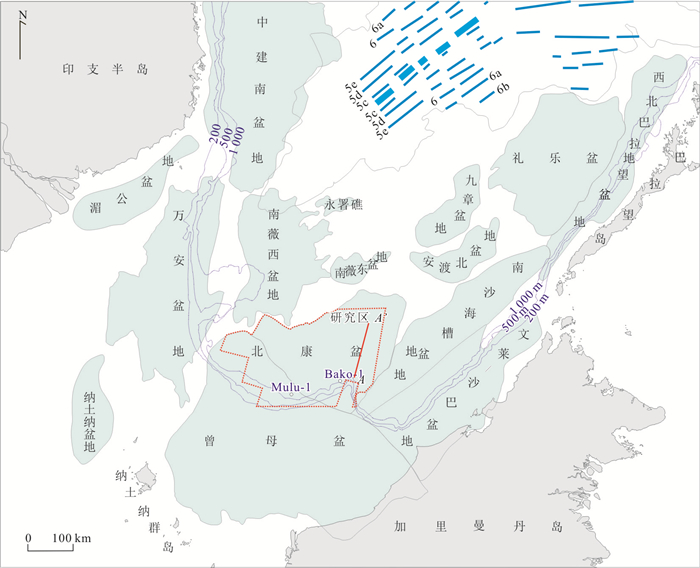
 下载:
下载:
